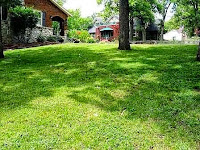 |
| Head of cockroach: image by Wikipedia commons |
Stop the roaches from entering your home by sealing cracks around your doors and windows and landscaping so that your gardens and shrubs are away from your foundation.
Everyone at some time or another in their lifetime experiences roaches. It does not matter how meticulous your home is roaches will invade your home or business.
There are 3500 species of cockroaches in the world and eventually, this insect will move into your home or business and scatter across your kitchen counter tops in search of food or linger in your bathroom for water.
If you allow the roaches to stay in your home for a short period of time they will settle in and multiply and before you know it your home or business will be infested.
Everyone at some time or another in their lifetime experiences roaches. It does not matter how meticulous your home is roaches will invade your home or business.
There are 3500 species of cockroaches in the world and eventually, this insect will move into your home or business and scatter across your kitchen counter tops in search of food or linger in your bathroom for water.
If you allow the roaches to stay in your home for a short period of time they will settle in and multiply and before you know it your home or business will be infested.
Last week I noticed a cockroach in my laundry room and knew if there was one there had to be at least 30 or more hiding out in my home. Roaches like to hide from humans and they seldom come out during the daylight hours, therefore if you want to conduct an inspection of your home then you need to turn off all of the lights, take your flashlight and open up your cabinet doors under your sink and also look behind your refrigerator, stove and in the bathroom under the sink cabinet.
like to hide from humans and they seldom come out during the daylight hours, therefore if you want to conduct an inspection of your home then you need to turn off all of the lights, take your flashlight and open up your cabinet doors under your sink and also look behind your refrigerator, stove and in the bathroom under the sink cabinet.
Look for droppings as they are signs of cockroaches. The droppings look like specks of black pepper and are primarily in areas where there is food or water. Should you determine that you do have roaches then you will need to inspect the exterior of your home for cracks, holes in your foundation, siding and crevices, also check around your windows and doors to make sure they are sealed.
Roaches will also enter your home through your drains in bathroom or kitchen and the air ducts. Seal all entrances to your home and place a drain cover in sinks and bath tub. Deter the roach from infesting your home by landscaping three to four feet from your home.
Many roaches reside in a moist habitat such as humus dirt or mulch. Install cement or rock barrier in between your landscape and your home and this will cut down on roaches from penetrating your home.
When you complete your outdoors tasks of sealing all entrances you will survey your living space. Check your home for cardboard storage boxes or shoe boxes. Shoe boxes are usually in a dark closet and roaches think of the box as an ideal living area. Remove shoes from boxes and place in an over the door hanger or in plastic under the bed storage unit. Also remove storage items from cardboard boxes and put in plastic storage containers with a locking lid. After the cardboard material is removed from your home you will need to concentrate on your kitchen and bath area.
with a locking lid. After the cardboard material is removed from your home you will need to concentrate on your kitchen and bath area.
Inspect under your sink and behind your appliances at night. Use a flashlight to look for roaches and or droppings. Remove roaches by killing them. Mix boric acid with granulated sugar and white flour.
Use equal parts for all ingredients.
Set the boric acid mixture in small open containers and set them behind the refrigerator, oven, and under the sink. The sweetness of the sugar will attract the cockroaches the flour is a binding ingredient that holds all ingredients together and the boric acid kills cockroaches, fleas, ants, ticks and other household pests.
kills cockroaches, fleas, ants, ticks and other household pests.
Look for droppings as they are signs of cockroaches. The droppings look like specks of black pepper and are primarily in areas where there is food or water. Should you determine that you do have roaches then you will need to inspect the exterior of your home for cracks, holes in your foundation, siding and crevices, also check around your windows and doors to make sure they are sealed.
Roaches will also enter your home through your drains in bathroom or kitchen and the air ducts. Seal all entrances to your home and place a drain cover in sinks and bath tub. Deter the roach from infesting your home by landscaping three to four feet from your home.
Many roaches reside in a moist habitat such as humus dirt or mulch. Install cement or rock barrier in between your landscape and your home and this will cut down on roaches from penetrating your home.
| Move landscape away from home |
When you complete your outdoors tasks of sealing all entrances you will survey your living space. Check your home for cardboard storage boxes or shoe boxes. Shoe boxes are usually in a dark closet and roaches think of the box as an ideal living area. Remove shoes from boxes and place in an over the door hanger or in plastic under the bed storage unit. Also remove storage items from cardboard boxes and put in plastic storage containers
Inspect under your sink and behind your appliances at night. Use a flashlight to look for roaches and or droppings. Remove roaches by killing them. Mix boric acid with granulated sugar and white flour.
Use equal parts for all ingredients.
Set the boric acid mixture in small open containers and set them behind the refrigerator, oven, and under the sink. The sweetness of the sugar will attract the cockroaches the flour is a binding ingredient that holds all ingredients together and the boric acid
Learn more about roach control: Youtube video




















